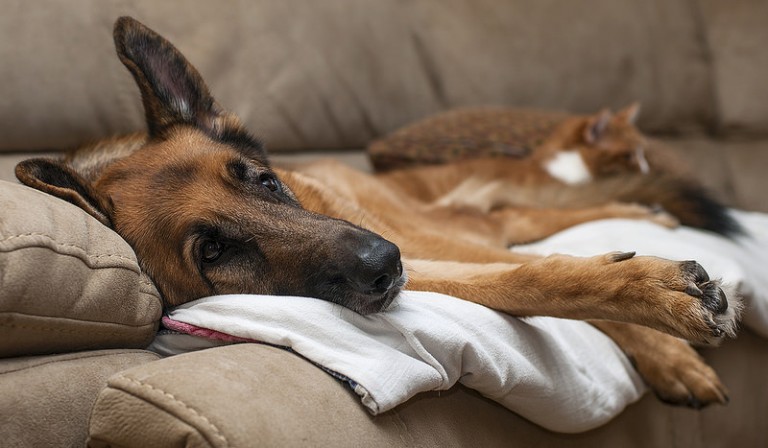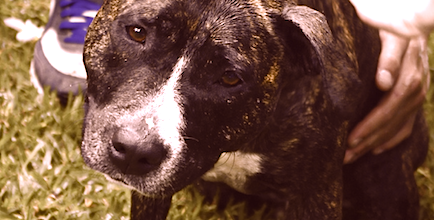Chinook Dog Breed Profile: Essential Facts
Chinooks are friendly and active but also highly intelligent, and this can be a recipe for funny antics and mischief. Learn more in our breed profile.
Chinook Dog
55 lbs. (females)

Don’t leave your pet’s safety to chance
Sign up for Petful recall alerts today.

Chinook Dog Characteristics
The Chinook is an athletic, intelligent dog, originally bred for sled racing. Known for being active and robust, this breed is built for endurance and strength.
Notable physical characteristics include:
- A thick double coat ranging from honey to reddish-gold shades.
- A muscular, compact body well-suited for agility and power.
- Slightly webbed toes, aiding mobility in snowy terrains.
- Almond-shaped eyes with colors varying from dark brown to amber.
Combining beauty with capability, the Chinook dog breed is suited to various outdoor adventures, thanks to its resilient and adaptable build.
Origin of the Chinook Dog Breed Profile: Essential Facts
The Chinook dog breed originated in the early 1900s, developed by breeder Arthur Walden in New Hampshire. Walden crossed a Mastiff-type dog with Greenland Huskies and German and Belgian Shepherds. Named after the location of Walden’s farm, “The Chinook Trail,” these dogs quickly became renowned for their power, endurance, and gentle temperament.
Notable historical events associated with the breed:
- 1925: Chinooks formed the first sled dog team to successfully climb Mount Washington.
- 1927: The breed gained international recognition after accompanying Admiral Richard Byrd on his Antarctic expedition.
- 1940: Perry and Honey Greene from Maine purchased Chinooks, becoming the breed’s exclusive breeders.
- 1965: Chinooks were listed as the rarest dog breed globally.
Due to dedicated breeding efforts and increased popularity, the number of registered Chinooks gradually rose from near extinction to hundreds registered today.
Purpose of the Chinook Dog Breed Profile: Essential Facts
Originally bred as sled dogs, Chinooks excelled in pulling heavy loads and covering long distances. While some Chinooks continue sledding work today, their versatility has expanded significantly.
Chinooks commonly engage in activities such as:
- Obedience training
- Drafting and carting
- Search and rescue operations
- Competitive racing events
Their active nature, combined with a strong affinity for human companionship, also makes the Chinook an ideal family pet.
Temperament of the Chinook Dog
The Chinook dog breed is playful, energetic, and friendly, known for their eagerness to please and adaptability to new situations. As highly intelligent dogs—sometimes referred to as the Einsteins of the canine world—they occasionally use this intelligence for mischievous purposes, cleverly figuring out how to achieve their goals.
Key temperament traits include:
- Non-aggressive nature; typically not suitable as guard dogs.
- Good compatibility with children and other non-canine pets.
- Preference for close human companionship; not suited for outdoor-only living or prolonged isolation.
- Potential vulnerability to anxiety if left alone or isolated frequently.
Due to their social and gentle nature, Chinooks thrive in homes where they’re regularly engaged, exercised, and thoroughly socialized to prevent excessive shyness or anxiety. Regular training helps manage mischievous tendencies and ensures balanced, well-adjusted behavior.
Is the Chinook the Right Dog for You?
Deciding if the Chinook is the right fit for your lifestyle comes down to a few key factors—especially their need for close human companionship. This is not a breed that enjoys solitude. If you’re considering bringing a Chinook into your home, here’s what you need to know:
Things to Consider:
- Constant companionship: Chinooks love being by your side—literally. Expect to be followed everywhere, including into the bathroom and around the house. If you’re someone who values personal space, this might not be the right breed for you.
- Separation sensitivity: They do not cope well with being left alone, caged, or kept outdoors. These situations can lead to emotional distress and separation anxiety.
- Training and socialization: Their intelligence is a blessing and a challenge. While they’re quick learners, their cleverness can lead to stubborn or sneaky behavior if not properly managed. Consistent training and early socialization are highly recommended.
- Good with families: Chinooks are known for being friendly and patient with children, as well as non-canine pets. However, they are not ideal as guard dogs due to their gentle temperament.
Exercise Needs of the Chinook Dog
HighHIGH: Daily exercise is essential for the Chinook dog breed. As naturally active and high-endurance dogs, Chinooks thrive when they have a job to do or a task to complete. Without regular physical activity, they may become bored or restless, which can lead to unwanted behaviors.
- Consistency is key: Aim for one or two daily walks along with dedicated playtime.
- Mental stimulation matters: In addition to physical activity, Chinooks enjoy having a purpose—activities like obedience drills, puzzle toys, or light pulling tasks can help satisfy their working instincts.
- Apartment-friendly: Despite their size and energy, Chinooks can adapt well to apartment living as long as their daily exercise needs are met.
- Supervised freedom: These dogs should not be let off-leash in open, unenclosed spaces. Some Chinooks have been known to exhibit herding behaviors when roaming freely, which can lead to unpredictable situations.
Meeting their exercise needs consistently helps ensure the Chinook stays happy, well-behaved, and healthy, making them a more enjoyable companion in any living environment.
This video shows two Chinook dogs participating in sledding:
Grooming Needs of the Chinook Dog
MediumMEDIUM: The Chinook dog breed has a thick double coat that typically sheds seasonally once or twice a year. However, some Chinooks may shed heavily throughout the year, even with routine grooming. Because of this variability, grooming needs can differ from dog to dog.
Grooming guidelines:
- Brushing: Weekly brushing is usually sufficient, but some Chinooks may require more frequent grooming during heavy shedding periods.
- Shedding: Be prepared for moderate to heavy shedding depending on the individual dog.
Basic Care:
- Brush teeth regularly to maintain oral health.
- Trim nails as needed to avoid discomfort or overgrowth.
- Clean ears routinely to prevent infections.
With a consistent grooming routine, most Chinook owners will find coat maintenance manageable—especially if they’re ready to adjust based on their dog’s unique shedding pattern.
Common Health Problems
MediumMEDIUM: With few health problems, the Chinook is generally a healthy breed with few problems. A few issues seen with the breed include:
- Eye problems
- Canine hip dysplasia
- Skin issues
- Cryptorchidism
- Seizures
- Spondylosis

Adopt, Don’t Shop
Shelters and rescues house purebred animals often, so start your search with these using our adoptable dog search. If you choose to purchase a Chinook through a breeder, please make sure they do not show any signs of operating a puppy mill. Ask to meet the dog’s parents and see any health records or tests that may have been performed on the parents and the dog you are adopting.
Related Dog Breed Profiles You May Like
- Cirneco dell’Etna Dog Breed Profile: Essential Facts
- Great Pyrenees Dog Breed Profile: Essential Facts
- Basenji Dog Breed Profile: Essential Facts
- Bouvier des Flandres Dog Breed Profile: Essential Facts
- Cane Corso Dog Breed Profile: Essential Facts
Frequently Asked Questions (FAQ)
What is a Chinook dog?
A Chinook dog is a rare, American-bred working breed originally developed for sledding, known for its strength, intelligence, and gentle temperament.
How much is a Chinook dog?
A Chinook dog typically costs around $1,000 to $2,500, depending on the breeder, lineage, and location.
What does a Chinook dog look like?
The Chinook has a muscular build, a thick double coat in shades of honey to reddish-gold, almond-shaped eyes, and slightly webbed toes.








